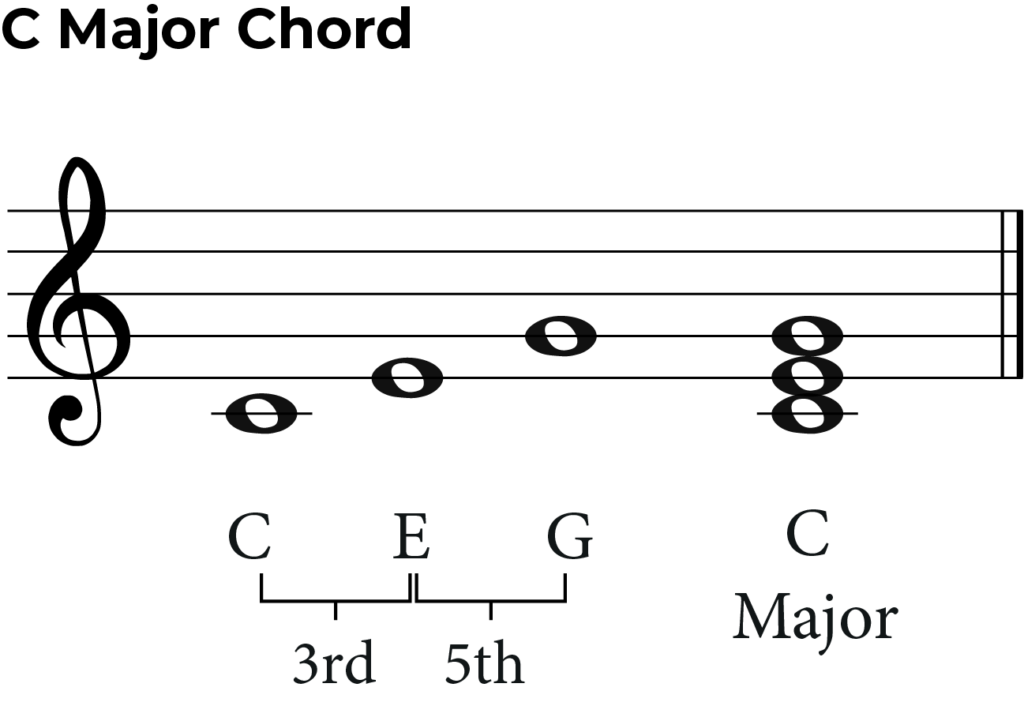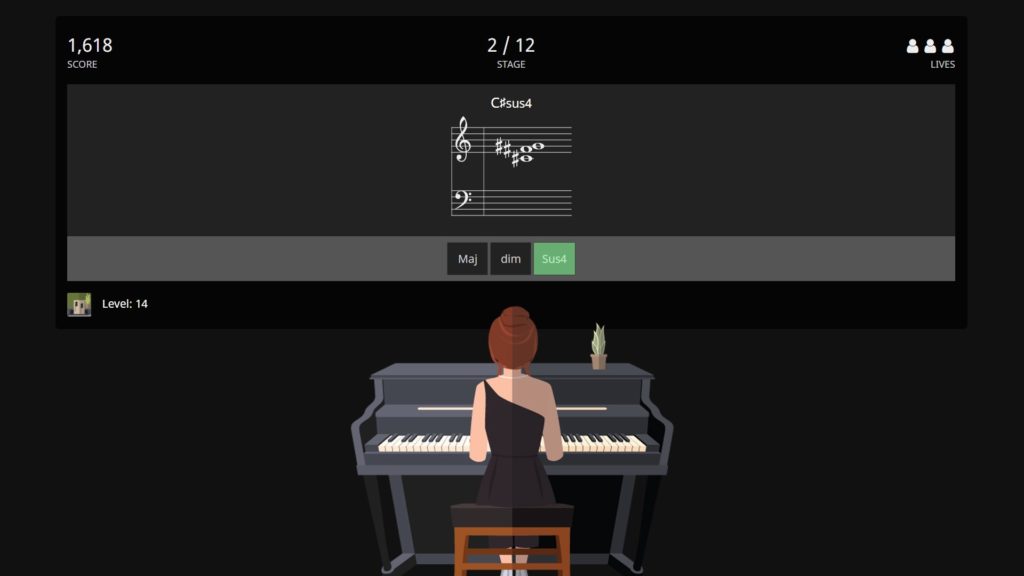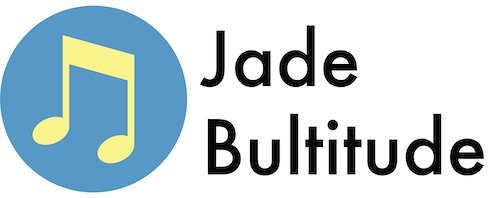Chords and chord building are a vital part of music theory and are the foundation of all music. In fact, it is impossible to write a piece of music without them! In this post we will explore what chords are in music and music theory, how to write them and build them, how to invert chords and how to label the chords and also how to use them when writing music.
Major Chords
Major chords have a clear and bright sound that typically conveys feelings of joy and optimism. The sound of a major chord is often described as full and resonant, making it a go-to for creating a cheerful and inviting musical atmosphere.
The formation of a major chord involves three notes:
- The root note, which establishes the chord’s basic pitch.
- A major third interval above the root
- A perfect fifth interval above the root, completing the chord with a full and rounded sound.

Two popular chord progressions featuring major chords are:
- The I-IV-V progression- a staple in blues, rock, and traditional pop, which cycles through the tonic, subdominant, and dominant chords, creating a satisfying and complete musical journey.
- The I-V-vi-IV progression, commonly found in pop music, which includes a minor chord (vi) for emotional depth while maintaining the uplifting quality of major chords.
A famous song that effectively uses major chords is “Let It Be” by The Beatles. In this song, major chords provide a comforting and hopeful sound, illustrating their power to evoke strong emotions and create memorable musical moments.
Minor Chords
Minor chords possess a distinctive sound that is often perceived as somber, reflective, or melancholic. This quality stems from the minor chord’s ability to evoke deeper emotions compared to the brighter and more upbeat major chords.
The structure of a minor chord is formed by three key components:
- The root note, which serves as the foundational pitch of the chord.
- A minor third interval above the root, imparting the chord’s characteristic somber tone.
- A perfect fifth interval above the root, which provides balance and fullness to the chord’s overall sound. For instance, an A minor chord is comprised of the notes A (the root), C (the minor third), and E (the perfect fifth), creating its signature introspective quality.

Two notable chord progressions that utilize minor chords are:
- The ii-V-i progression, a classic in jazz and classical music, which leads the listener through a sequence of tension and resolution, ending on the minor tonic for a satisfying closure.
- The vi-IV-I-V progression, often used in pop and rock, where the initial minor chord adds a poignant contrast to the subsequent major chords.
An iconic song that prominently features minor chords is “Stairway to Heaven” by Led Zeppelin. The use of minor chords in this song contributes to its hauntingly beautiful atmosphere, highlighting their ability to convey complex emotions and enhance the narrative depth of music.
Diminished Chords
Diminished chords have a distinct sound that is often described as tense, unstable, or mysterious. The sound of a diminished chord is characterized by its dissonance, which can evoke feelings of unease or anticipation in the listener.
A diminished chord is formed by:
- The root note
- A minor third interval above the root
- A diminished fifth interval above the root, which is what gives the diminished chord its distinctive tension and dissonance. For example, a B diminished chord includes the notes B (the root), D (the minor third), and F (the diminished fifth), creating its signature unsettled sound.

Two common uses of diminished chords in chord progressions are:
- As a passing chord between major or minor chords to increase tension and release within a progression.
- Leading into a resolution, often appearing before the tonic in a vii°-I progression in classical music or jazz, heightening the sense of resolution when the music returns to the tonic chord.
A famous piece that utilizes diminished chords to great effect is “Michelle” by The Beatles. In this song, the use of diminished chords adds complexity and a touch of melancholy to the harmonic structure, enhancing the song’s emotional depth.
Augmented Chords
Augmented chords are known for their dissonant sound that can evoke a sense of tension or unresolved feeling. Unlike the more stable major and minor chords, augmented chords have a unique quality that can dramatically alter the mood and direction of a piece of music.
An augmented chord is constructed with the following intervals:
- The root note
- A major third interval above the root.
- An augmented fifth interval above the root, which is one half step higher than the perfect fifth found in major and minor chords. This alteration creates the tension and distinctive sound of the augmented chord. For instance, a C augmented chord would consist of C (the root), E (the major third), and G# (the augmented fifth), offering a sound that stands out for its unresolved tension.

In terms of chord progressions, augmented chords are less commonly used as the primary chord but rather:
- Employed as transitional or passing chords to add color and tension, particularly in jazz and classical music compositions.
- Utilized to modulate to different keys or to introduce a sense of instability before resolving back to a more stable chord.
A notable song that features an augmented chord is “Oh! Darling” by The Beatles. In this track, the use of an augmented chord adds a dramatic flair and contributes to the song’s emotional intensity, showcasing how augmented chords can be effectively used to enrich the musical texture and convey complex emotions.
Seventh Chords
Seventh chords are triads with an additional note, this additional note is a seventh above the root.
There are six common types of chords in this section:
- Dominant seventh chord
- Minor seventh chord
- Major seventh chord
- Diminished seventh chord
- Half diminished chord
- Augmented seventh chord
There are more of these types of chords in your music but this is a great place to start.
Dominant seventh chord
Dominant seventh chords are built using a major triad on the fifth note of the scale and then a flat seventh, also known as the dominant seventh, added on top!
For example in the key of G major, the Dominant seventh chord would start on the note D, the fifth note of the scale. (The fifth note of any scale is called the dominant note)
G A B C D
We would then have a major triad starting on D. The notes in a D major triad are – D F# A
We then simply add a flattened seventh on the top of this major triad. In this case it would be a C natural!
As you can see C is the seventh scale degree of D major but normally in D major we would have a C#. Having a C natural is flattened down by a semitone from the original note C sharp.

Minor Seventh Chord
A minor seventh chord is built using a minor triad with a minor seventh added to the top.
Lets take a look at an example in C minor. The tonic triad of C minor is C, Eb, G now we simply add a minor seventh to the top of this chord. The minor seventh from C natural is Bb. (If these intervals are confusing, have a look at our intervals article). So the chord will be as follows:
C, Eb, G, Bb

Major Seventh Chord
A major seventh triad consists of a major triad with an additional major seventh added to the top.
For example let’s take the G major tonic triad. This has the notes G, B, D
We now simply add a major seventh to the top of this triad. This would be an F sharp as a major seventh above G natural is an F sharp.
G major seventh will have the notes G, B, D, F sharp

Diminished Seventh Chord
Diminished seventh chords consist of a diminished triad with a diminished seventh added to the top.
Let’s write out a diminished chord starting on B.
A diminished chord starting on B includes the notes B, D, F – remember in a diminished chord we must make sure that the interval of a fifth is diminished.
We can now add in a diminished seventh to the top of this chord. A diminished seventh above B natural is A flat.
So B diminished includes the notes B, D, F, Ab.

Half Diminished Chord
Half diminished chords have a diminished triad with an additional minor seventh. Where a diminished chord had both intervals diminished this one is half diminished because only one of the intervals is diminished!
Let’s look at an example in C minor
C minor diminished triad has the notes C, Eb, Gb
Now we simply add in the minor seventh to the top. A minor seventh from C natural is Bb
So C minor half diminished chord has the notes C, Eb, Gb, Bb

Augmented Seventh Chord
Augmented seventh chords are built using an augmented triad with an added minor seventh.
Let’s look at an example in C major
A C major augmented triad will include the notes C, E, G#. Remember for it to be an augmented triad the interval of a fifth must be an augmented fifth.
Now we simply need to add a minor seventh on the top. The minor seventh above this would be a B flat.
A C major augmented seventh will be C, E, G#, Bb

Extended Chords
Extended chords are chords that extend past the seventh degree of the chord. An extended chord uses notes from the second octave of a scale:

Once we get past the octave, or the 8th note of the scale, we simply continue counting on – 9th, 10th, 11th etc
In an extended chord we continue adding thirds above, remember chords are most commonly tertian meaning stacking thirds.
These will include 9th, 11th and 13th notes above the root.
Below is an example of some common extended chords

Altered Chords
An altered chord is where one of the notes in the diatonic chord is changed or moved up or down by one semitone. When making an altered chord, you need to remember not to change the tonic, third or seventh notes as these will alter the chord too much.
To learn more about altered chords then check out this blog post.

Suspended Chords
A suspended chord is one that includes a suspended note. This is almost always a triad with it’s 3rd substituted for a 2nd or a 4th.
There are many other examples so to learn more about them please checkout this blog post.

Ear Training and Chords
To develop as a musician you’ll want to be able to recognise chords by ear. This is where ear training comes in. My recommendation for this is Tonegym as they have a comprehensive and fun program for training your ears! It’s what has gotten the best results with for my own students.
In the ‘tools’ section of their site, Tonegym even have a chord player that allows you to listen virtually any chord.
For an in-depth look at ear training, here’s my full review of Tonegym.

Quartal and Quintal Chords
Although most chords are tertian, meaning built on stacking thirds, there are some exceptions to the rule and these are quartal and quintal chords!
A quartal chord is built by stacking fourths – these fourths will usually either be perfect or augmented. Perfect fourths are the most common.
A quintal chord is, you guessed it, built by stacking fifths!

FAQs
What Exactly is a Chord?
A chord is simply a set of notes or pitches that are played simultaneously. Chords are most commonly built using superimposed thirds. A chord is essentially two or more different intervals, the interval of a third most commonly. If you do not feel confident with intervals do make sure to read the blog post on intervals before embarking on this post about chords.
The chord type that we most commonly see and use is the triad. Triads are simply three note chords. ‘Tri’ comes from the greek language and simply means three, think about a triangle!

A chord doesn’t just have to consist of three notes, it can also consist of four or more notes. The most common types of chord that have more than three notes are seventh chords or extended chords, but more on this later. Let’s look at triads first.
What are triads?
As stated earlier, a triad is a chord consisting of three notes. It is built using the root, a third above the root and then a fifth above the root. See below an example of the C major triad. The notes in this triad are C, E, G.

A triad is a type of tertian chord. A tertian chord is where we stack multiple thirds on top of each other.
In order to confidently build chords, you need to be really certain of your scales. Knowing and understanding your scales helps you to know what notes to include in your chords. To refresh your memory on this topic make sure to check out the scales blog here!
It is also useful to really understand what intervals are and how to work them out as chords are built up using different intervals. Having a clear idea of not only how to work out the intervals number but also its descriptive word is vital when learning about chords. When reading on you will see why.
Let’s write out the scale in the key of C major. There are seven notes/degrees in total in the C major scale and we can easily write a triad on every single one of these scale degrees. By the time we have finished there will be seven different chords.

As you can see, each chord includes the root, a third above the root and a fifth above the root! Remember, the root is simply the bottom note of each triad/chord.
Make sure you notice that each of these chords is either written on all lines or all spaces.
- Chord I includes the notes c, e, g
- Chord II includes the notes d, f, a
- Chord III includes the notes e, g, b
- Chord IV includes the notes f, a, c
- Chord V includes the notes g, b, d
- Chord VI includes the notes a, c, e
- Chord VII includes the notes b, d, f
There are four main triads that you will come across and these are:
- Major Triad – A Major third and a Perfect fifth above the root
- Minor Triad – A Minor third and a Perfect fifth above the root
- Diminished Triad – A Minor third and a Diminished fifth above the root
- Augmented Triad – A Major third and an Augmented fifth above the root
How Do We Use chords?
Chords are the foundation of all harmony. In a music composition we have to use chord progressions to support the notes in your melody. A chord progression is a sequence of chords in a specific order. These chords support the melody and the rhythm and are absolutely key to writing your own songs and compositions. To learn more about chords progressions make sure to check out this blog post.

